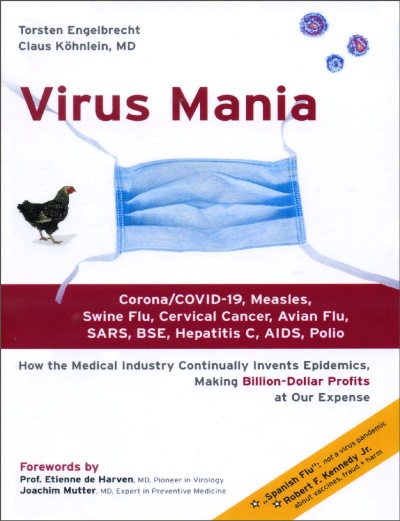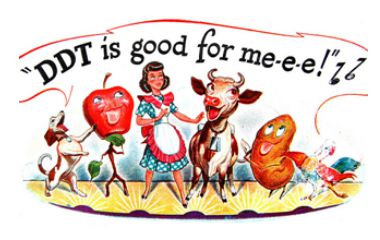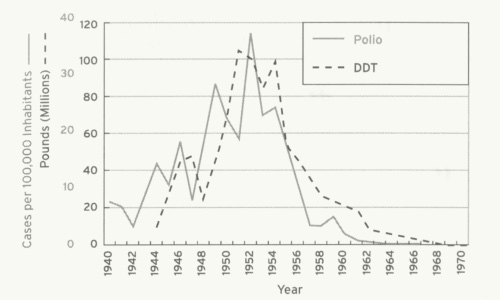

Review of the book Virus Mania
Brane Žilavec, 21 December 2020

Torsten Engelbrecht & Claus Köhnlein, MD
Virus Mania, 2020
This is the second, extended edition of the book that was first published in 2007. Its subtitle ‘How the Medical Industry Continually Invents Epidemics, Making Billion-Dollar Profits at Our Expense’, reveals the main aim of authors – one journalist and one medical specialist of internal diseases – to conduct an independent investigation of available scientific evidence about the topic of epidemics. The first two chapters cover a short history of the development of the theory of microbes as agents of diseases established by Louis Pasteur (1822-1895) in France and Robert Koch (1843-1910) in Germany in contradistinction of scientists, such as Claude Bernard (1813-1878) who, like Rudolf Steiner (1861-1925), were pointing attention to the conditions of the terrain (in a person’s body) that enable the multiplication of germs.
Seeing microbes as the enemies of humanity goes back to Pasteur’s belief that microbes could not be found in a healthy body and that microbes ‘flying through the air on dust particles’ must be responsible for all possible diseases. This view had led him to the conviction that “it must lie within human power to eliminate all diseases caused by parasites from the face of the Earth.”
The notes of Pasteur’s experiments were not available to the public until the late 20th century, when it was discovered that his experiments paving the way for the prevalent theory of microbes as agents of diseases did not satisfy basic scientific standards. Concerning Koch, we learn about his involvement in the first large scale vaccination fraud with his alleged ‘miracle drug’, Tuberkulin, aimed at people suffering with pulmonary tuberculosis. As this drug contained just a bacillus culture killed by heat, it did not help, on the contrary, many experienced dramatic adverse reactions, such as chills, high fever, and even death.
However, these inaccuracies and misconducts of pioneers of microbiology did not prevent ‘microbe hunters’ and ‘virus hunters’– as they are named by authors of the book – rising to power inside the medical establishment. The dogma of a single cause for disease was decisively shaped by microbiology at the end of the 19th century, declaring specific microorganisms (viruses, bacteria, fungi) to be the causes of very definite diseases. With this microbe theory the cornerstone was laid for the basic formula of modern biomedicine: one disease - one cause - one cure/miracle pill/vaccine. This simplified formula was embraced and supported with a lot of money by then relatively young pharmaceutical industry; and due to ongoing media’s propaganda – presenting germs and viruses as deadly enemies of humanity – it gradually became deeply entrenched in the collective consciousness.
The further chapters are dedicated to detailed descriptions of events and main actors that have collaborated at the emergence of epidemic of AIDS, hepatitis C, BSE (mad cow disease), SARS, avian flu, cervical cancer, swine flu, and corona/Covid-19. [1] While reading through them one can start to recognize underlying approaches and the use of methods that have been enabling the recurring ‘inventions’ and propagation of ever-new epidemics.
One method is glossing over the clear lack of sound scientific evidence for the main claims of the virus hunters. For example, any claim of the existence of so-called ‘killer viruses’ must first be proven. But so far in all epidemics that are surveyed in the book “scientifically-sound evidence has never been provided, even though it’s as easy as taking a sample of patient blood and isolating one of these viruses, in a purified form with its complete genetic material (genome) and virus shell, directly from it, and then imaging it with an electron microscope.” Instead of these verifiable steps we have databases of genetic structures of supposed viruses and indirect ‘proofs’ of their existence by means of antibody tests and PCR (polymerase chain reaction) tests. But antibody tests just prove the existence of antibodies – and not the virus or particle itself to which the antibody tests react. That means that “as long as the virus or cell particle (antigen) has not been precisely defined, no one can say what these antibody tests are reacting to; they are thus ‘unspecific’ in medical lingo.”
The same problem occurs with PCR testing that is used to track down genetic sequences (short DNA or RNA pieces) that are typical for specific virus. Without the complete cleaning (purification/isolation) of particles which is an indispensable pre-requisite for detection of a virus, it cannot be known which specific virus we are dealing with, or if it is a virus at all. For example, in the case of the corona pandemic it cannot be concluded that the RNA gene sequences ‘pulled’ from the swabs and calibrated to the PCR tests belong to a very specific virus, to SARS-CoV-2. It could be any virus from the corona family, or even new non-viral gene sequences created by cells due to various chemical shocks.
The authors have asked the World Health Organization, the American Center for Disease Control, and its German counterpart, the Robert Koch Institute in Berlin, the following three questions:
And despite repeated questioning they haven’t received any answer. This reveals that scientific studies supporting proclamations of the above listed epidemics in the last decades don’t exist. The same is true in regard to the present corona pandemic.
Another approach that enable constant invention of epidemics is an unwillingness to investigate any other causative factors that contribute to emergence of infectious diseases, in spite of the fact that “it is also conceivable that toxic drugs like poppers (recreational drugs commonly used by homosexuals), or immunosuppressive medications like antibiotics and antivirals could trigger what is called oxidative stress. This means that the blood’s ability to transport oxygen, so important for the life and survival of cells, is compromised. Simultaneously, nitric oxides are produced, which can severely damage cells. As a result, antibody production is ‘stirred up,’ which in turn causes the antibody tests to come out positive. Also, new genetic sequences are generated through this, which are then picked up by the PCR tests – all this, mind you, without a pathogenic virus” entering from outside.
An illustrative example of ignorance of other causative factors is the historical link of the polio epidemic in the USA with the use of pesticides, among which was the widespread use of DDT: spraying it over fields, countryside and swamps (against mosquitoes); disinfecting flocks of animals (against parasites), and immigrants and children (against lice). There were even advertisements enthusiastically proclaiming DDT as being “good for you,” “harmless,” and a “miracle substance”. However, already at that time there were medical experts providing sound evidence that “toxins like pesticides such as DDT produce the paralysis symptoms so typical of polio.”

One expert has revealed that “when in 1945 DDT was released for use by the general public in the US and other countries, an impressive body of toxicological investigations had already shown beyond doubt that this compound was dangerous for all animal life, from insects to mammals.” This expert concluded that “the spread of polio after the Second World War was caused by the most intensive campaign of mass poisoning in known human history.” This campaign has been finally halted only due to the impact of Rachel Carson’s book Silent Spring, published in 1962, although it took another ten years before the US government prohibited use of DDT.

In the book authors analyze in great detail numerous possible causes of so called infectious illnesses such as pharmaceuticals, lifestyle drugs, pesticides, heavy metals, pollution, stress and processed (and genetically modified) foods. [2] They point out that all of these impacts can heavily damage the body of humans and animals and even kill them.
The third practice we can find in the descriptions of various invented epidemics is the rife corruption at all levels of the public health services that enable the pharmaceutical companies and researchers to make enormous profits. This would not be possible if the present scientific culture were not ruled by secretiveness, privilege-granting, lack of accountability, and by blatant lack of monitoring. Without this the virus hunters could not scare people by ‘deadly viruses’ and hide from them “very basic scientific facts that the existence, the pathogenicity and the deadly effects of viruses have never been proven.” And such acknowledgment would then open the door to investigate another possibility that the alleged contagious viruses could be particles produced by the cells themselves as a consequence of certain stress factors such as environmental toxins and drugs. This option is mentioned a few times in the book (including various quoted authors) and would, in my opinion, demand more attention and research.
The verdict of authors in regard to the present ‘total corona mania’ (designation by authors) is that “it is impossible to conclude that only what is called SARS-CoV-2 can be considered as the cause of the symptoms in patients who have the ‘Covid-19’ label attached.” For such conclusion would be possible only:
As none of these conditions are fulfilled we must arrive at the conclusion that we are dealing with new case of invented pandemic.
One of the authors, doctor Köhnlein, has his own medical practice where he also treats hepatitis C and AIDS patients, who are sceptical of mainstream treatments, and offers some basic guidelines about “side effect-free alternatives to medications and vaccinations.” According to him the best way to combat infectious diseases is to detoxify our body as much as possible and to strengthen one’s own immune system by the consumption of natural, enzyme rich foods (such as fresh fruit and vegetables), by replacing refined foods with natural wholefoods and by developing a more holistic view of health instead of ‘pill-popping’. Although these insights are mentioned only very briefly in a few places they are important part of the book. [3]
The epilogue of the current edition describes the case of celebrity endorsement [4] of the new AIDS industry by movie star Rock Hudson, who was diagnosed as having AIDS just three years after the “discovery of the first cluster of symptomatic patients” [5] in the US. In 1985 Hudson publicly announced that he was dying of AIDS and this created enormous publicity – in spite of the fact that he died due to negative accumulative effects to his liver from decades of smoking, drinking and using recreational drugs [6] – combined in the last year of his life with highly toxic medications that have liver-destroying effects. The boom of the AIDS ‘industry’ paved the way for all consequent epidemics that have been hugely benefiting owners of pharmaceutical companies, politicians, researchers, doctors and journalists alike – all at the expense of patients. For they pay the highest price of all, without getting what they deserve and need most to maintain health: enlightenment about real causes and therapies that could well prevent, and certainly contribute, to the cure of their illnesses.
This thought provoking in-depth investigation should be mandatory reading for all anthroposophical doctors who are writing or lecturing about the corona pandemic to avoid the spreading of false claims of ‘virus hunters’ that the novel coronavirus was already identified as a cause of Covid-19. [7] For spiritual scientists are obliged to become familiar with all possible explanations of genuine materialistic science about the origins of epidemics before they present to the public also the missing spiritual explanations. Otherwise, people will not be capable of attaining the true understanding of this very complex topic that is at the present time engaging the attention of the whole of humanity.

NOTES